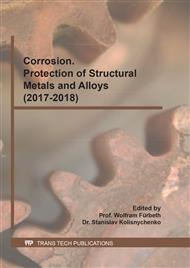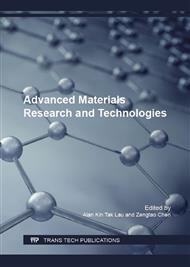[1]
S. Peng, B. Bhushan. Mechanically durable superoleophobic aluminum surfaces with microstep and nanoreticula hierarchical structure for self-cleaning and anti-smudge properties, J. Colloid Interface Sci. 461 (2016) 273-284.
DOI: 10.1016/j.jcis.2015.09.027
Google Scholar
[2]
U. Eduok, R. Suleiman, M. Khaled, R. Akid, Enhancing water repellency and anticorrosion properties of a hybrid silica coating on mild steel, Prog. Org. Coat. 93 (2016) 97-108.
DOI: 10.1016/j.porgcoat.2016.01.006
Google Scholar
[3]
S. Zheng, C. Li, Q. Fu, W. Hu, T. Xiang, Q. Wang, M. Du, X. Liu, Z. Chen, Development of stable superhydrophobic coatings on aluminum surface for corrosion-resistant, self-cleaning, and anti-icing applications, Mater. Des. 93 (2016): 261-270.
DOI: 10.1016/j.matdes.2015.12.155
Google Scholar
[4]
Z. Zheng, Y. Liu, Y. Bai, J. Zhang, Z. Han, L. Ren, Fabrication of biomimetic hydrophobic patterned graphene surface with ecofriendly anti-corrosion properties for Al alloy, Colloids Surf., A 500 (2016): 64-71.
DOI: 10.1016/j.colsurfa.2016.04.008
Google Scholar
[5]
T. Nishino, M Meguro, K Nakamae, M Matsushita, The lowest surface free energy based on -CF3 alignment, Langmuir 15. 13 (1999), 4321-4323.
DOI: 10.1021/la981727s
Google Scholar
[6]
A Ganne, V. Lebed, A. Gavrilov, Combined wet chemical etching and anodic oxidation for obtaining the superhydrophobic meshes with anti-icing performance, Colloids Surf., A 499 (2016): 150-155.
DOI: 10.1016/j.colsurfa.2016.04.019
Google Scholar
[7]
X. Zhang, R. Chen, Y. Liu, J. Hu, Electrochemically generated sol–gel films as inhibitor containers of superhydrophobic surfaces for the active corrosion protection of metals, J. Mater. Chem. A 4 (2016): 649-656.
DOI: 10.1039/c5ta07443f
Google Scholar
[8]
B. Wu, M. Zhou, J. Li, X. Ye, G. Li, L. Cai, Superhydrophobic surfaces fabricated by microstructuring of stainless steel using a femtosecond laser, Appl. Surf. Sci. 256 (2009): 61-66.
DOI: 10.1016/j.apsusc.2009.07.061
Google Scholar
[9]
L. Jiang, Y. Zhao, J. Zhai, A lotus‐leaf‐like superhydrophobic surface: a porous microsphere/nanofiber composite film prepared by electrohydrodynamics, Angew. Chem. 116 (2004): 4438-4441.
DOI: 10.1002/ange.200460333
Google Scholar
[10]
W. Stöber, A. Fink, E. Bohn, Controlled growth of monodisperse silica spheres in the micron size range, J. Colloid Interface Sci. 26 (1968) 62-69.
DOI: 10.1016/0021-9797(68)90272-5
Google Scholar
[11]
H. Chen, Z. Sun, J. Shao, Investigation on FT-IR spectroscopy for eight different sources of SiO2, J. Chin. Ceram. Soc. 30 (2011) 934-937.
Google Scholar
[12]
W. Wang, F. Hou, H. Wang, H. Guo, Fabrication and characterization of Ni–ZrO2 composite nano-coatings by pulse electrodeposition, Scripta Mater. 53 (2005) 613-618.
DOI: 10.1016/j.scriptamat.2005.04.002
Google Scholar
[13]
A.B.D. Cassie, S. Baxter, Wettability of porous surfaces, Trans. Faraday Soc. 40 (1944) 546-551.
DOI: 10.1039/tf9444000546
Google Scholar
[14]
Z. Cheng, L. Hao, A. Chen, Q. Song, C. Chen. A rapid one-step process for fabrication of superhydrophobic surface by electrodeposition method, Electrochim. Acta 59 (2012) 168-171.
DOI: 10.1016/j.electacta.2011.10.045
Google Scholar
[15]
B. Bhushan, E. Her, Fabrication of superhydrophobic surfaces with high and low adhesion inspired from rose petal, Langmuir 26 (2010) 8207-8217.
DOI: 10.1021/la904585j
Google Scholar
[16]
T. Liu, S. Chen, S. Cheng, J. Tian, X. Chang, Y. Yin, Corrosion behavior of super-hydrophobic surface on copper in seawater, Electrochim. Acta 52 (2007) 8003-8007.
DOI: 10.1016/j.electacta.2007.06.072
Google Scholar



